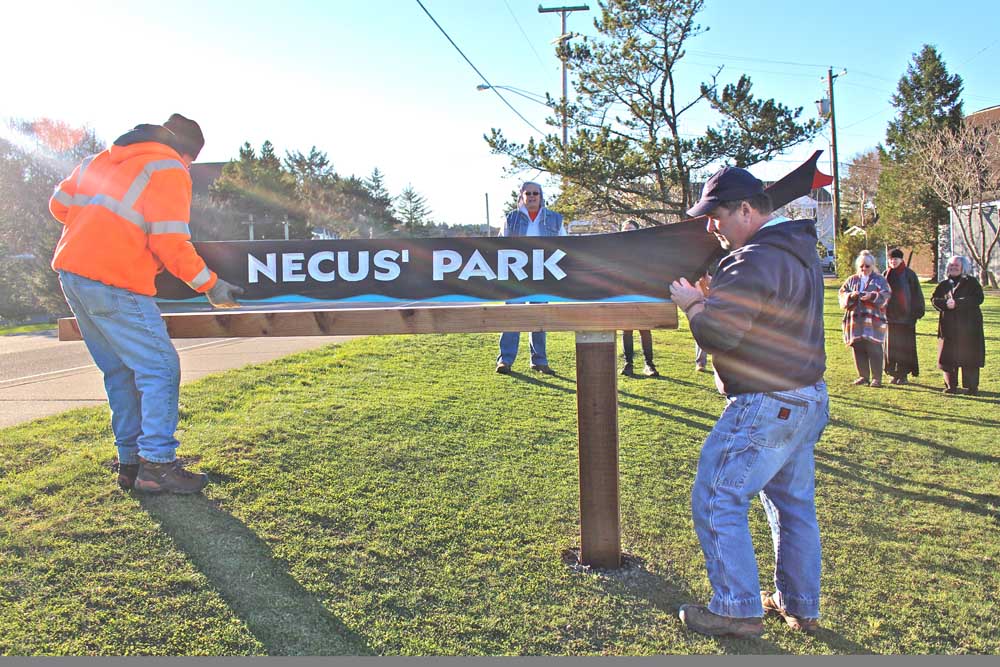Listening — really listening — is the only way to learn the message
Published 7:00 pm Thursday, March 5, 2015

- Richard and Roberta Basch of the Clatsop-Nehalem Confederated Tribes spoke at the Listening to the Land talk recently in Seaside.
“We are the land. The stories of our people — we’re all about the land.”
And so, the tale of the Native Americans who lived on the North Coast hundreds — thousands — of years before pioneer settlers ever approached began.
It was a standing-room-only crowd in the Seaside Public Library community room during the “Listening to the Land” lecture sponsored by the North Coast Land Conservancy.
For two hours we listened to Dick Basch, the vice chairman of the Clatsop-Nehalem tribes, and his wife, Roberta, who calls herself a “Heinz 57” of tribal affiliations.
Through slides showing old photographs, Dick introduced us to his great-grandfather, Joe Duncan, “who lived when the land was gone” and took up logging to “keep the family alive.”
There were other slides, of another tribal member, Simon, first as a young boy in the 1800s, then as a young man, who left the North Coast for 10 years to attend school. As a young lawyer, Simon returned home and saw how the settlers had occupied the land of his ancestors.
The settlers, Dick said, saw that the land “provided everything people needed.”
“Simon was the first to file lawsuits against the federal government for return of the land,” Dick said, raising his chin and smiling ever so slightly.
The slides showed his grandfather clam digging and, later, with family at Indian Beach.
For many, many years Indian children were raised on the beach, at Arch Cape or Hug Point, Dick said.
“Indian Beach was one of the last holdouts,” he said of the area now part of Ecola State Park. “It was one of the last places we had people living in a village.”
Another slide showed Dick as a child, at what is now called NeCus’ Park, which once was the former playground of Cannon Beach Elementary School. The photo was taken in 1955, the sesquicentennial celebration of Lewis and Clark’s arrival on this land.
Even as he described the slide and how he had come dressed for his Indian role, Dick couldn’t mask the excitement he still felt about that day 60 years ago when he gathered with family and friends on land where a Clatsop village once stood.
“We lost a lot of our culture,” he said. “We sort of pushed it down because it wasn’t accepted.”
The loss of culture may have started as long ago as 1851, when Clatsop Chief Tostow signed a treaty with the federal government; he was clearly not happy about it.
When asked why he was days late arriving to sign the document, Tostow told the government officials, “We were not so very anxious to sell our homes and be driven away like so many birds as we have heard was to be done as soon as we sold our lands.”
Although the treaty reassured the Clatsops that their fishing rights would be protected on Neacoxie Creek and that they would be free to walk along the beach, later they found that newly constructed fences barred them from the land they had once occupied and had fed them.
“It’s hard to understand how it really happened,” Dick told us. “How it happened here.”
But with the Clatsop-Nehalem tribe’s recent participation in the Canoe Project, the tribe’s smoldering spirit caught fire. The Canoe Project, which required the tribe first to find a cedar log large enough to build a 36-foot-long canoe, then to carve it, brought the Northwest tribes together as they embarked on canoe trips along the Pacific Coast to visit each other and attend celebrations.
From those ongoing explorations, Roberta Basch said, the tribes are learning their songs and sharing stories. They trade information about wild herbs and flowers that can be applied as medicine or eaten for nourishment.
And, they continue to listen to the land.
Neahkahnie Mountain, Roberta said, is “one of the most powerful places on Earth” and remains a sacred place. Saddle Mountain also is revered by the Clatsops.
“People don’t understand what makes us different, why we are connected to the earth,” Roberta said.
“We’re sent out to listen,” she added. “When we’re listening to the land, we’re forming a relationship with the land. … There’s a dance of energy and color in every single plant.”
This relationship — a way of “connecting with your soul” — she calls “Indian science.” It’s what “European science,” which involves experimentation, measurement, hypotheses and proofs, is missing.
“Imagine how powerful it would be if they were matched together,” Roberta Basch said.
As I left the lecture, I wondered why so many people had turned out on a Wednesday night to listen to Dick and Roberta, who are already well known on the North Coast. Perhaps it was curiosity. Maybe it was a genuine desire to learn more about the Indians’ history about the land we all share.
But I hope, in any case, we all listened closely. And we keep listening.
That’s the only way healing will begin.
Nancy McCarthy covers South Clatsop County as a reporter for The Daily Astorian. She also is the editor of the Seaside Signal and the Cannon Beach Gazette.
‘There’s a dance of energy and color in every single plant.’
— Roberta Basch
Native American on how they relate to the land




